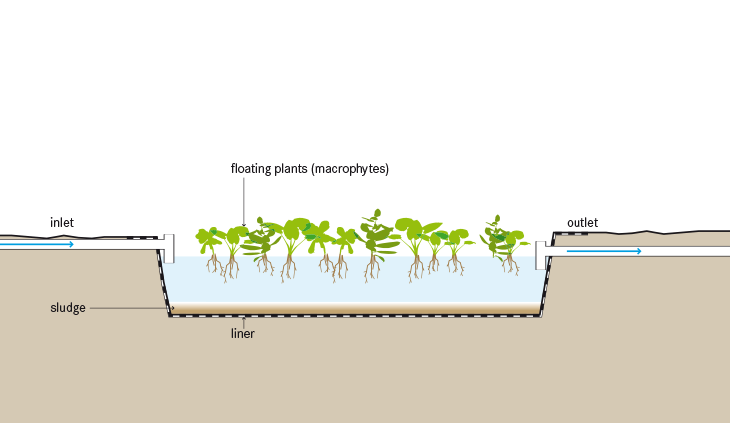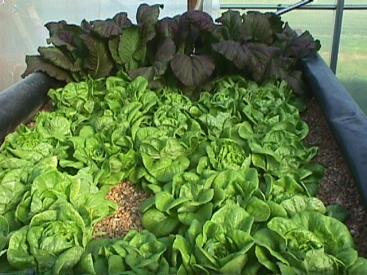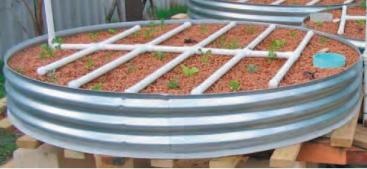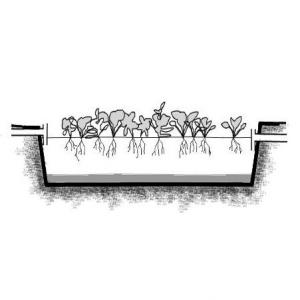Executive Summary
The term aquaculture refers to the controlled cultivation of aquatic plants and animals by making use of various types of wastewater as a source for nutrients and/or warm temperatures for plants and fishes to grow. In aquacultural plant production the plants are grown mainly with two different methods: ‘Hydroponics’ is where the cultivated plants are grown with plant roots directly exposed to water; and ‘Floating Plant Ponds. A floating plant pond is a modified maturation pond with floating (macrophyte) plants. Plants such as water hyacinths or duckweed float on the surface while the roots hang down into the water to uptake nutrients and filter the water that flows by. You can also read the description of aquaculture with anmials.
| In | Out |
|---|---|
Freshwater, Blackwater, Greywater, Brownwater, Fertigation Water |
Treated Water, Food Products |
Floating plant ponds
Commonly used plants in floating plant ponds are water hyacinths and duckweed. Water hyacinths are perennial, freshwater, aquatic macrophytes that grow especially fast in wastewater. The plants can grow large: between 0.5 to 1.2 m from top to bottom. The long roots provide a fixed medium for bacteria which in turn degrade the organics in the water passing by.
Duckweed is a fast growing, high protein plant that can be used fresh or dried as a food for fish or poultry. It is tolerant of a variety of conditions and can significantly remove quantities of nutrients from wastewater.

Functional schematic of a floating plant pond. Source: TILLEY et al. (2014)
Design considerations
Locally appropriate plants can be selected depending on their availability and the characteristics of the wastewater.
To provide extra oxygen to a floating plant technology, the water can be mechanically aerated but at the cost of increased power and machinery. Aerated ponds can withstand higher loads and can be built with smaller footprints (see also aerated ponds). Non-aerated ponds should not be too deep otherwise there will be insufficient contact between the bacteria-harbouring roots and the wastewater. A well-designed and maintained floating plant pond system can add value and interest to otherwise barren land. Adequate signage and fencing should be used to prevent people and animals from coming in contact with the water. Floating plants require constant harvesting. The harvested biomass can be used for small artisanal businesses, or it can be composted. Mosquito problems can develop when the plants are not harvested regularly. Depending on the amount of solids entering, the pond must be desludged periodically (see also waste stabilization ponds or free-surface constructed wetland.
Health aspects/acceptance
Water hyacinth has attractive, lavender flowers. A well designed and maintained system can add value and interest to otherwise barren land.
Adequate signage and fencing should be used to prevent people and animals from coming in contact with the water. Workers should wear appropriate protective clothing. WHO guidelines on wastewater and excreta use in aquaculture should be consulted for detailed information and specific guidance.
Operation & maintenance
Floating plants require constant harvesting. The harvested biomass can be used for small artisanal businesses, or it can be composted. Mosquito problems can develop when the plants are not regularly harvested. Depending on the amount of solids that enter the pond, it must be periodically desludged. Trained staff is required to constantly operate and maintain it.
Hydroponics
Plants are grown in a liquid solution consisting of water and the required nutrients of a particular plant, or within a system that uses a substrate or growing mix medium in addition to the liquid (water) nutrient flow. There are a variety of techniques and systems that exist for producing plant crops using the principals of hydroponics.

Growing of lettuce in gravel bed, with a fish production effluent flowing through. Source: CALS (n.y.)
In traditional land planted farming, the soil acts as a reservoir to hold moisture, nutrients and micronutrients. Soil is usually the medium, in which the liquid and absorbable plant nutrients are retained. However, the soil itself is not an essential food for plant growth. When the nutrients that are retained within the soil dissolve in water, plant roots are able to absorb and utilize them.
Water culture hydroponic systems include the nutrient film technique, aeroponics, and the aeration method. Plants are anchored using various types of screens, rigid pipes or films. The required nutrients are determined based on the plant needs and mixed into a plant's water supply artificially. Nutrient-rich wastewater flowstreams such as urine, reclaimed water from wastewater treatment plants, pretreated greywater or water coming from fish production ponds can be used as a source of water and nutrients. The amount that can be used depends on the nutrient demand of the plant and the available nutrients in the effluent. Plant roots are suspended within the water by various means and designs and the crop obtains the required food nutrients directly from the water or in the case of aeroponics a water air mist is sprayed directly unto the plant roots. The nutrient liquid is constantly exchanged and rejuvenated.
Other types of hydroponic systems use various solid type mediums that are generally composed from relatively inert materials that have the ability to retain the food rich moisture and also to serve as means of physical support for the plant roots. Modified growing mediums include; expanded clay, rock wool, perlite, vermiculite, coral rock, pea gravel, sand, Styrofoam and other mediums.

Backyard hydroponics in Western Australia. Source: DIVER (2006)
Almost any plant can be grown within hydroponics systems, but some will do better than others. Today, thousands of farms use hydroponic systems to produce, tomatoes, lettuce, watercress, chinese cabbages, bock choy and many different herbs and hundreds of other edible plants. Many operators also produce shoots of plants including beans, and barley to be used in other food products for human or animal consumption. Varieties of flowers and even tree seedlings are grown using hydroponics.
A floating plant pond is only appropriate when there is a sufficient amount of land (or pre-existing pond). It is appropriate for warm or tropical climates with no freezing temperatures, and preferably with high rainfall and minimal evaporation. Trained staff is required for the constant operation and maintenance of the pond. The technology can achieve high removal rates of both BOD and suspended solids, although pathogen removal is not substantial.
Harvested hyacinths can be used as a source of fibre for rope, textiles, baskets, etc. Depending on the income generated, the technology can be cost neutral (see budget allocation and resource planning) . Duckweed can be used as the sole food source for some herbivorous.
Hydroponics are an option in areas with poor soil quality or where agricultural land is not sufficiently available. It allows for efficient agricultural production on a minimised production area. .
Integrated Systems of Agriculture and Aquaculture. Aquaculture in the Classroom
Small and Decentralized Wastewater Management Systems
Decentralised wastewater management presents a comprehensive approach to the design of both conventional and innovative systems for the treatment and disposal of wastewater or the reuse of treaded effluent. Smaller treatment plants, which are the concern of most new engineers, are the primary focus of this book.
CRITES, R. TCHOBANOGLOUS, G. (1998): Small and Decentralized Wastewater Management Systems. New York: The McGraw-Hill Companies IncHydroponics
This document, rich in pictures, gives a good overview on the history of hydroponics and describes a variety of hydroponic methods and techniques.
DEPARTMENT OF AGRICULTURE SRI LANKA (n.y): Hydroponics. Peradeniya: Sri Lanka: Department of Agriculture URL [Accessed: 21.04.2011]Aquaponics – Integration of Hydroponics with Aquaculture
Aquaponics is a bio-integrated system that links recirculating aquaculture with hydroponic vegetable, flower, and/or herb production. Recent advances by researchers and growers alike have turned aquaponics into a working model of sustainable food production. This publication provides an introduction to aquaponics with brief profiles of working units around the country. An extensive list of resources point the reader to print and Web-based educational materials for further technical assistance.
DIVER, S. (2006): Aquaponics – Integration of Hydroponics with Aquaculture. Arkansas, USA: ATTRA - National Sustainable Agriculture Information Service URL [Accessed: 22.05.2012]Duckweed Aquaculture
This literature review provides a first overview of the possibilities, potentials and limits of duckweed aquaculture and its combined use in wastewater treatment and animal feed production in low and middle-income countries. It is somewhat limited as critical literature on duckweed field use is scarce and difficult to obtain (e.g. unpublished internal documents).
IQBAL, S. (1999): Duckweed Aquaculture. Potentials, Possibilities and Limitations for Combined Wastewater Treatment and Animal Feed Production in Developing Countries. Duebendorf: Swiss Federal Institute of Aquatic Science and Technology (Eawag) URL [Accessed: 08.05.2019]Comparative Study of Wastewater Lagoon with and without Water Hyacinth
Hydroponics is the growing of plants without soil
Community-Based Technologies for Domestic Wastewater Treatment and Reuse- options for urban agriculture
The report suggests that emerging trends in low-cost, decentralised naturally-based infrastructure and urban wastewater management which promote the recovery and reuse of wastewater resources are increasingly relevant. Technologies for these sanitation options are presented. The concept of managing urban wastewater flows at a decentralised or "intermediate" level, based on micro watersheds, is explored. Effluent treatment standards that are currently accepted in order to protect public health and safety are reviewed.
ROSE, D.G. (1999): Community-Based Technologies for Domestic Wastewater Treatment and Reuse- options for urban agriculture. (= Cities Feeding People (CFP) Report Series. , 27 ). Ottawa: International Development Research Center Canada (IDRC) URL [Accessed: 23.05.2018]Duckweed Aquaculture: A New Aquatic Farming System for Developing Countries
The purpose of this booklet is to present a group of tiny aquatic plants commonly known as "duckweeds" as a promising new commercial aquaculture crop.
SKILLICORN, P. SPIRA, W. JOURNEY, W. (1993): Duckweed Aquaculture: A New Aquatic Farming System for Developing Countries. Washington: The World Bank URL [Accessed: 15.04.2014]Compendium of Sanitation Systems and Technologies. 2nd Revised Edition
This compendium gives a systematic overview on different sanitation systems and technologies and describes a wide range of available low-cost sanitation technologies.
TILLEY, E., ULRICH L., LÜTHI, C., REYMOND P. and ZURBRÜGG C. (2014): Compendium of Sanitation Systems and Technologies. 2nd Revised Edition. Duebendorf, Switzerland: Swiss Federal Institute of Aquatic Science and Technology (Eawag) URL [Accessed: 03.05.2023] PDFDesign Manual – Constructed Wetlands and Aquatic Plant Systems for Municipal Water Treatment
This document is a very complete design manual about constructed wetlands and aquatic plant systems for municipal water treatment. It describes different designs, application, performance and it includes several case studies.
U. S. EPA (1998): Design Manual – Constructed Wetlands and Aquatic Plant Systems for Municipal Water Treatment. Washington D.C.: United States : Environmental Protection Agency (EPA) URL [Accessed: 24.08.2011]Guidelines for the safe use of wastewater excreta and greywater. Volume III. Wastewater and Excreta Use in Aquaculture
Volume III of the Guidelines for the Safe Use of Wastewater, Excreta and Greywater deals with wastewater and excreta use in aquaculture and describes the present state of knowledge regarding the impact of wastewater-fed aquaculture on the health of producers, product consumers and local communities. It assesses the associated health risks and provides an integrated preventive management framework.
WHO (2006): Guidelines for the safe use of wastewater excreta and greywater. Volume III. Wastewater and Excreta Use in Aquaculture. Geneva: World Health Organisation URL [Accessed: 08.05.2019]Compendium of Sanitation Systems and Technologies (Arabic)
This is the Arabic version of the Compendium of Sanitation Systems and Technologies. The Compendium gives a systematic overview on different sanitation systems and technologies and describes a wide range of available low-cost sanitation technologies.
TILLEY, E. ULRICH, L. LUETHI, C. REYMOND, P. SCHERTENLEIB, R. ZURBRUEGG, C. (2014): Compendium of Sanitation Systems and Technologies (Arabic). 2nd Revised Edition. Duebendorf, Switzerland: Swiss Federal Institute of Aquatic Science and Technology (Eawag) PDFAquatic Plant Based Water Treatment Systems in Asia
Harvesting and Handling of Biomass
Chapter 4: Water Hyacinth Ponds
Small and Decentralized Wastewater Management Systems
Decentralised wastewater management presents a comprehensive approach to the design of both conventional and innovative systems for the treatment and disposal of wastewater or the reuse of treaded effluent. Smaller treatment plants, which are the concern of most new engineers, are the primary focus of this book.
CRITES, R. TCHOBANOGLOUS, G. (1998): Small and Decentralized Wastewater Management Systems. New York: The McGraw-Hill Companies IncHydroponics
This document, rich in pictures, gives a good overview on the history of hydroponics and describes a variety of hydroponic methods and techniques.
DEPARTMENT OF AGRICULTURE SRI LANKA (n.y): Hydroponics. Peradeniya: Sri Lanka: Department of Agriculture URL [Accessed: 21.04.2011]Aquaponics – Integration of Hydroponics with Aquaculture
Aquaponics is a bio-integrated system that links recirculating aquaculture with hydroponic vegetable, flower, and/or herb production. Recent advances by researchers and growers alike have turned aquaponics into a working model of sustainable food production. This publication provides an introduction to aquaponics with brief profiles of working units around the country. An extensive list of resources point the reader to print and Web-based educational materials for further technical assistance.
DIVER, S. (2006): Aquaponics – Integration of Hydroponics with Aquaculture. Arkansas, USA: ATTRA - National Sustainable Agriculture Information Service URL [Accessed: 22.05.2012]Water Quality Study of Graywater Treatment Systems
Duckweed Aquaculture
This literature review provides a first overview of the possibilities, potentials and limits of duckweed aquaculture and its combined use in wastewater treatment and animal feed production in low and middle-income countries. It is somewhat limited as critical literature on duckweed field use is scarce and difficult to obtain (e.g. unpublished internal documents).
IQBAL, S. (1999): Duckweed Aquaculture. Potentials, Possibilities and Limitations for Combined Wastewater Treatment and Animal Feed Production in Developing Countries. Duebendorf: Swiss Federal Institute of Aquatic Science and Technology (Eawag) URL [Accessed: 08.05.2019]A Prototype Recirculating Aquaculture-Hydroponic System
This document introduces a recirculating aquaculture-hydroponic system. The system provides an artificial, controlled environment that optimises the growth of aquatic species and soil-less plants, while conserving water resources. In this system, fish and plants are grown in a mutually beneficial, symbiotic relationship.
JOHNSON, M. D. WARDLOW, G. W. (1997): A Prototype Recirculating Aquaculture-Hydroponic System. Arkansas, USA: University of Arkansas, Department of Agricultural & Extension Education URL [Accessed: 21.04.2011]Possibilities and Limits of Wastewater-fed Aquaculture
At the University of Applied Sciences Waedenswil, Switzerland, wastewater-fed aquaculture is a research focus since 1993. This paper summarises some of the results and insights gained since then.
JUNGE-BERBEROVIC, R. University of Applied Sciences Waedenswil. (2001): Possibilities and Limits of Wastewater-fed Aquaculture. Waedenswil: University of Applied Sciences Waedenswil URL [Accessed: 19.02.2010]Aquatic plants for domestic wastewater treatment: Lotus (Nelumbo nucifera) and Hydrilla (Hydrilla verticillata) systems
The study focussed on the overall performances of lotus and hydrilla systems for post treatment of domestic wastewater. Removal of water quality parameters such as pH, biochemical oxygen demand, suspended substances, nitrogen, phosphorus and total coliform bacteria showed the differences between various plants and control unitas.
KANABKAEW, T. ; PUETPAIBOON, U. (2004): Aquatic plants for domestic wastewater treatment: Lotus (Nelumbo nucifera) and Hydrilla (Hydrilla verticillata) systems. In: Songklanakarin J. Sci. Technology: Volume 26 , 749-756. URL [Accessed: 21.04.2011]Comparative Study of Wastewater Lagoon with and without Water Hyacinth
Wastewater Treatment and Use in Agriculture
This Irrigation and Drainage Paper is intended to provide guidance to national planners and decision-makers, agricultural and municipal managers, field engineers and scientists, health and agricultural field workers, wastewater treatment plant operators and farmers. Consequently, it covers a broad range of relevant material, some in considerable depth but some more superficially. It is meant to encourage the collection, treatment and use of wastewater in agriculture in a safe manner, with maximum advantage taken of this resource. Informal, unplanned and unorganized wastewater use is not recommended, nor is it considered adviseable from the health or agricultural points of view.
PESCOD, M.B. (1992): Wastewater Treatment and Use in Agriculture. (= FAO Irrigation and Drainage Paper , 47 ). Rome: Food and Agriculture Organisation of the United Nations (FAO) URL [Accessed: 25.10.2011]Aquatic plants in Aquaculture
The article informs the reader about the biological role of aquatic plants in the waters with specific information on the anatomy of aquatic plants and descriptions of different types of plants.
PONGCHAWEE, K. (n.y): Aquatic plants in Aquaculture. India: Aquatic Plants and Ornamental Fish Research Institute URL [Accessed: 21.04.2011]Community-Based Technologies for Domestic Wastewater Treatment and Reuse- options for urban agriculture
The report suggests that emerging trends in low-cost, decentralised naturally-based infrastructure and urban wastewater management which promote the recovery and reuse of wastewater resources are increasingly relevant. Technologies for these sanitation options are presented. The concept of managing urban wastewater flows at a decentralised or "intermediate" level, based on micro watersheds, is explored. Effluent treatment standards that are currently accepted in order to protect public health and safety are reviewed.
ROSE, D.G. (1999): Community-Based Technologies for Domestic Wastewater Treatment and Reuse- options for urban agriculture. (= Cities Feeding People (CFP) Report Series. , 27 ). Ottawa: International Development Research Center Canada (IDRC) URL [Accessed: 23.05.2018]Water plants
This factsheet informs the reader about the most common water plants used for floating plant ponds. There are further information on growing and harvesting the plants. It is illustrated with many pictures.
SHARP, D. (n.y): Water plants. South Africa: Water Affairs, Agriculture Forestry and Fisheries, Environmental Affairs URL [Accessed: 21.04.2011]Duckweed Aquaculture: A New Aquatic Farming System for Developing Countries
The purpose of this booklet is to present a group of tiny aquatic plants commonly known as "duckweeds" as a promising new commercial aquaculture crop.
SKILLICORN, P. SPIRA, W. JOURNEY, W. (1993): Duckweed Aquaculture: A New Aquatic Farming System for Developing Countries. Washington: The World Bank URL [Accessed: 15.04.2014]Hydroponics 101. Yo, Where’s the dirt?
This article provides general information on the topic of hydroponics. The reader gets to known what this technology is about. Several global key data are given and various examples for implementation are described.
SPIEGELMAN, A. (n.y): Hydroponics 101. Yo, Where’s the dirt?. New York, USA: Annie Spiegelman URL [Accessed: 21.04.2011]Compendium of Sanitation Systems and Technologies. 2nd Revised Edition
This compendium gives a systematic overview on different sanitation systems and technologies and describes a wide range of available low-cost sanitation technologies.
TILLEY, E., ULRICH L., LÜTHI, C., REYMOND P. and ZURBRÜGG C. (2014): Compendium of Sanitation Systems and Technologies. 2nd Revised Edition. Duebendorf, Switzerland: Swiss Federal Institute of Aquatic Science and Technology (Eawag) URL [Accessed: 03.05.2023] PDFDesign Manual Onsite Wastewater Treatment and Disposal Systems
Rather old design manual for onsite wastewater treatment options. However, valuable information on established systems such as septic tanks, sand filters, aerobic treatment units (suspended growth and fixed film), disinfection, nutrient removal as well as wastewater segregation and recycling are given. Additional information is given on disposal methods and appurtenances.
U.S.EPA (1980): Design Manual Onsite Wastewater Treatment and Disposal Systems. (= EPA 625/1-80-012 ). United States Environmental Protection Agency, Office of Water Office of Research and Development (U.S.EPA) URL [Accessed: 18.03.2010]Guidelines for the safe use of wastewater excreta and greywater. Volume III. Wastewater and Excreta Use in Aquaculture
Volume III of the Guidelines for the Safe Use of Wastewater, Excreta and Greywater deals with wastewater and excreta use in aquaculture and describes the present state of knowledge regarding the impact of wastewater-fed aquaculture on the health of producers, product consumers and local communities. It assesses the associated health risks and provides an integrated preventive management framework.
WHO (2006): Guidelines for the safe use of wastewater excreta and greywater. Volume III. Wastewater and Excreta Use in Aquaculture. Geneva: World Health Organisation URL [Accessed: 08.05.2019]Volume III: Wastewater and excreta use in aquaculture.
This presentation gives a detailed overview on the 3. volume of the WHO guidelines on the safe use of wastewater and excreta in aquaculture including many pictures of existing wastewater-fed aquaculture and fish pond technologies all over the world. Apart from the health risk and appropriate health protection measures, a lot of information on socio-cultural, environmental and economic aspects is given as well as supporting information on planning and implementation of sewage-fed fish ponds.
EDWARDS, P. (2008): Volume III: Wastewater and excreta use in aquaculture.. (pdf presentation). Bangkok, Thailand: Asian Institute of TechnologyKey Issues in the Safe Use of Wastewater and Excreta in Aquaculture
This document is a guidance note for program managers and engineers that summarises the key issues of the 3. Volume of the WHO Guidelines that focuses on the safe use of wastewater and excreta in aquaculture.
EDWARDS, P. Asian Institute of Technology (2008): Key Issues in the Safe Use of Wastewater and Excreta in Aquaculture. (pdf presentation). (= Guidelines for the Safe Use of Wastewater, Excreta and Greywater in Agriculture and Aquaculture , 3 ). Bangkok, Thailand: World Toilet Organisation URL [Accessed: 19.02.2010]http://www.fishfarming.com/
This webpage describes the sustainable technology of growing plants (duckweed) and fish (Tilapia) in a symbiotic way. The text is illustrated with various pictures (English).
http://ag.arizona.edu/
This webpage shows many pictures of integrated systems of aquaculture and agriculture. Furthermore, the most important facts and key figures are given.
http://aquaponicsworld.net/Aquaponics
This webpage provides information on large-scale aquaculture systems. It contains information on aquaculture for producing crops and gives information on farming in this very special field.
http://www.webofcreation.org/
This webpage is about aquaponics. Aquaponics is the combination of aquaculture and hydroponics. While algae, submerged plants, and floating plants do a good job of removing fish wastes from a recirculating aquaculture system, so can lettuce, basil, or many other common vegetables and herbs. Fish wastes can be treated with a biofilter and then allowed to pass through hydroponic troughs, where the roots of cultivated plants can remove the wastes as fertiliser.


